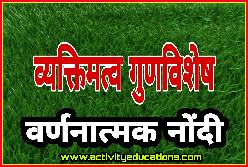WATER-पाणी-स्वच्छ विद्यालय पुरस्कारासाठी पुनर्मुल्यांकन तपासणी- swachh vidyalaya puraskar 2022 Verification
शिक्षण मंत्रालय, भारत सरकार नवी दिल्ली व राज्य शैक्षणिक संशोधन व प्रशिक्षण परिषद, महाराष्ट्र, पुणे आयोजित स्वच्छ विद्यालय पुरस्कार संदर्भात मुख्याध्यापकांनी आपल्या शाळेचे रजीष्ट्रेषण करून माहिती भरलेली असून फोटो अपलोड केलेले आहेत, या भरलेल्या माहितीचे जिल्हास्तरीय पथकाद्वारे पुनर्मुल्यांकन करणे सुरु आहे, आपल्या शाळेत आलेले पथक कोणकोणत्या बाबीची तपासणी करणार आणि कोणकोणते फोटो काढून अपलोड करणार आहेत याची सविस्तर माहिती येथे आपण पाहणार आहोत
WATER
• Access to Safe, Adequate and Reliable Drinking Water
• Availability of Water for Use in Toilet and Handwashing
पाणी
• सुरक्षित, पुरेसे आणि विश्वासार्ह पिण्याच्या पाण्याचा प्रवेश
• शौचालय आणि हात धुण्यासाठी वापरण्यासाठी पाण्याची उपलब्धता
1. What is the main source of drinking water, available in the school campus? *
a) No drinking water source available in school campus (students may bring water from home / use outside source)
b) Unimproved Source: Unprotected- well/ spring, surface water: lake, river, stream, pond, canals, irrigation ditches
c) Improved Source: Hand pump/ Boreholes/ tube wells or packaged water (bottled / sachet), protected- well/spring/ rainwater catchment/ harvesting (collection), Delivered water (Tanker-trucks /Cart with small tank / drum)
d) Piped Water Supply
1. शाळेच्या आवारात पिण्याच्या पाण्याचा मुख्य स्त्रोत कोणता आहे? *
अ) शाळेच्या आवारात पिण्याच्या पाण्याचा स्रोत उपलब्ध नाही (विद्यार्थी घरातून पाणी आणू शकतात / बाहेरचा स्रोत वापरू शकतात)
ब) सुधारित स्त्रोत: असुरक्षित- विहीर/ झरे, पृष्ठभागाचे पाणी: तलाव, नदी, नाले, तलाव, कालवे, सिंचन खड्डे
c) सुधारित स्त्रोत: हातपंप/ बोअरहोल्स/ ट्यूबवेल किंवा पॅकेज केलेले पाणी (बाटलीबंद/पाच), संरक्षित- विहीर/ स्प्रिंग/ पावसाचे पाणी पाणलोट/ हार्वेस्टिंग (संकलन), वितरित पाणी (टँकर-ट्रक/छोट्या टाकी/ड्रमसह कार्ट)
ड) पाईपद्वारे पाणी पुरवठा
2. Is adequate drinking water (at least 1.5 litre per child per day in non-residential & 5 litre per child per day in residential school) available from this water supply, all days throughout the year? *
a) No, not available (unavailable > 30 days total)
b) Mostly Available (unavailable <= 30 days total)
c) Yes (always)
2. या पाणीपुरवठ्यातून वर्षभर पुरेशा प्रमाणात पिण्याचे पाणी (अनिवासी शाळेत किमान 1.5 लिटर प्रति बालक प्रति दिवस आणि निवासी शाळेत प्रति बालक 5 लिटर) उपलब्ध आहे का? *
अ) नाही, उपलब्ध नाही (अनुपलब्ध > एकूण ३० दिवस)
ब) बहुतेक उपलब्ध (अनुपलब्ध <= एकूण 30 दिवस)
c) होय (नेहमी)
3. How is drinking water stored and handled by most of the students? *
a) No storage system for storing drinking water
b) Container /pitcher only
c) Container/pitcher with lid and ladle
d) Container with taps
e) Overhead storage tank with drinking water taps
3. बहुतेक विद्यार्थ्यांद्वारे पिण्याचे पाणी कसे साठवले जाते आणि हाताळले जाते? *
अ) पिण्याचे पाणी साठवण्यासाठी कोणतीही साठवण व्यवस्था नाही
b) फक्त कंटेनर/घडा
c) झाकण आणि लाडू असलेले कंटेनर/घागरा
ड) नळांसह कंटेनर
e) पिण्याच्या पाण्याच्या नळांसह ओव्हरहेड साठवण टाकी
4. Is the drinking water treated at the source regularly (safe drinking water availability) to make it safe for consumption? *
a) No treatment
b) Filtration/ Solar disinfection
c) Boiling/ Adding chlorine/ Bleaching powder (Chlorination) Treated at water source-no treatment required in the school
d) Advanced treatment unit (RO, UV, micro-filtration, etc.)
4. पिण्याचे पाणी वापरासाठी सुरक्षित करण्यासाठी नियमितपणे स्त्रोतावर प्रक्रिया केली जाते (सुरक्षित पिण्याचे पाणी उपलब्धता)? *
अ) उपचार नाही
ब) गाळण्याची प्रक्रिया किंवा सोलर निर्जंतुकीकरण
c) उकळणे / क्लोरीन जोडणे / ब्लिचिंग पावडर (क्लोरीनेशन) पाण्याच्या स्त्रोतावर प्रक्रिया केली जाते - शाळेत उपचार आवश्यक नाहीत
ड) प्रगत उपचार युनिट (आरओ, यूव्ही, मायक्रो-फिल्ट्रेशन इ.)
5. Is the quality of drinking water tested (please upload the copy for the test for biological and chemical test information) *
a) No testing
b) Tested once in a year
c) Tested twice or more times in a year
5. पिण्याच्या पाण्याची गुणवत्ता तपासली गेली आहे (कृपया जैविक आणि रासायनिक चाचणी माहितीसाठी चाचणीची प्रत अपलोड करा) *
अ) चाचणी नाही
b) वर्षातून एकदा चाचणी केली जाते
c) वर्षातून दोनदा किंवा अधिक वेळा चाचणी केली
6. How many functional drinking water points are there in the school? *
6. शाळेत पिण्याच्या पाण्याचे किती कार्यक्षम बिंदू आहेत? *
7. What is the main source of water for use in toilets? *
a) No water supplies available
b) Hand pump/ bucket/ tap near toilet unit
c) Drums/ cement tanks/ plastic containers with water inside the toilet unit
d) Running water with taps inside each toilet unit
7. शौचालयात वापरण्यासाठी पाण्याचा मुख्य स्त्रोत कोणता आहे? *
अ) पाणी पुरवठा उपलब्ध नाही
ब) टॉयलेट युनिटजवळ हातपंप/बाल्टी/टॅप
c) टॉयलेट युनिटमध्ये पाणी असलेले ड्रम/सिमेंट टाक्या/प्लास्टिकचे कंटेनर
d) प्रत्येक टॉयलेट युनिटमध्ये नळांसह वाहणारे पाणी
8. What is the main source of water used for hand washing before Mid-Day Meal (MDM) / lunch by students and cooks? *
a) No water supplies available
b) Hand pump/ bucket/tap near handwashing area
c) Drums/ cement tanks/ plastic containers with water near hand washing area
d) Running water with taps at all the hand washing points
8. विद्यार्थी आणि स्वयंपाकी यांनी मिड-डे मील (MDM) / दुपारच्या जेवणापूर्वी हात धुण्यासाठी वापरल्या जाणार्या पाण्याचा मुख्य स्त्रोत कोणता आहे? *
अ) पाणी पुरवठा उपलब्ध नाही
ब) हात धुण्याच्या क्षेत्राजवळ हातपंप/ बादली/ नळ
c) हात धुण्याच्या जागेजवळ ड्रम/सिमेंटच्या टाक्या/प्लास्टिकचे डबे पाणी असलेले
ड) हात धुण्याच्या सर्व ठिकाणी नळांनी पाणी वाहून नेणे
9. Is there a functional rain water harvesting facility in the school? *
a) No
b) Yes – Groundwater recharge system
c) Yes – Rain water storage system
d) Both rainwater storage and groundwater recharge system
9. शाळेत पावसाचे पाणी साठवण्याची सोय आहे का? *
अ) नाही
b) होय – भूजल पुनर्भरण प्रणाली
c) होय – पावसाचे पाणी साठविण्याची व्यवस्था
ड) पावसाचे पाणी साठवण आणि भूजल पुनर्भरण प्रणाली दोन्ही











0 Comments